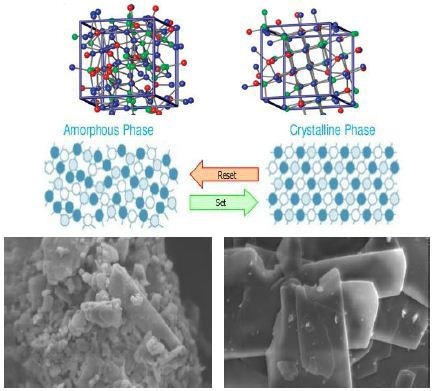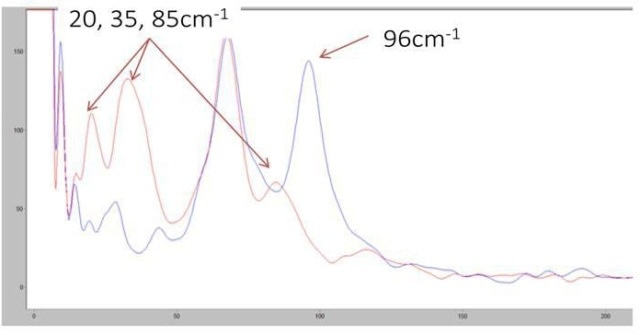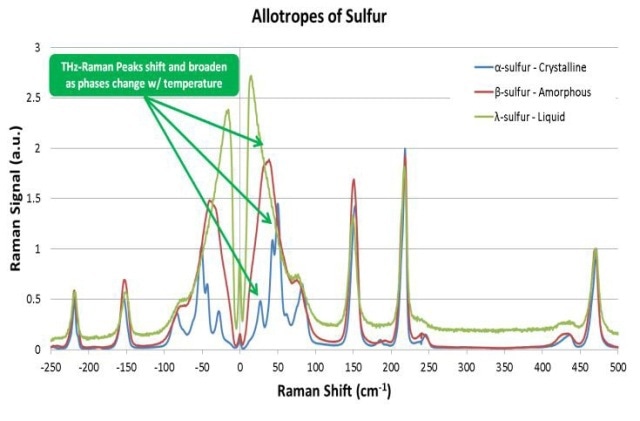Control and measurement of reactions, amorphous states and/or crystallization rates is vital for chemical, pharmaceutical and electronics industries. Unambiguous and clear determination of material structure (including polymorphs), crystallinity, and phase is necessary for formulation, chemical process development, stability testing and material characterization.
Various measurement modes need special sample preparation for offline, destructive analysis, and do not provide real-time feedback. This article outlines the advantages of THz- Raman® systems over traditional methods to monitor and control reactions and crystallization rates.

Figure 1. Clear, unambiguous determination of material structure (such as polymorphs), crystallinity, and phase is essential to chemical process development, formulation, and stability testing and material characterization.
Existing Techniques
Determining structural or phase changes in a material can be done in a variety of ways, such as Raman spectroscopy, X-ray diffraction (XRD) techniques, and Terahertz (THz) spectroscopy.
Although Raman spectroscopy is employed to monitor small band shifts in the “fingerprint” region (200- 1800 cm-1), these show slight shifts in functional groups, and are usually difficult to detect during polymorphic or phase changes.
XRD techniques offer quantitative and conclusive analysis, but the need for destructive, off-line testing, and expensive equipment is their major drawback.
THz spectroscopy can easily differentiate structural shifts, but limited spectroscopic range, high cost, moisture sensitivity, and the need for special sample preparation are its major shortcomings.
Coherent Systems
The range of traditional Raman spectroscopy can be extended by THz-Raman® systems to the THz/low frequency regime. This is where differentiation of inter- and intra-molecular structures, which correlate to material structure and material phase, can be clearly observed.
THz-Raman spectra can distinguish co-crystals, polymorphs, synthetic pathways, contaminants, crystal defects, and can be used as a real-time monitor of molecular structure. Anti-Stokes signals also improve SNR, and add to Raman intensity.
Low frequency spectra are used to monitor the transformation of polymorphs. The waterfall plot, shown in Figure 2, displays anhydrous theophylline before and after its transformation within slurry into a monohydrate, over a time period of about 100 seconds.

Figure 2. Anhydrous theophylline before and after its transformation into monohydrate
The features of Coherent systems include:
- Rapid, real-time monitoring of phase changes and material structure
- In-situ, non-destructive, and does not need sample preparation
- Quantitative measurement of crystalline/amorphous mixtures
- Simultaneous structural and chemical analysis
- Compatible with traditional Raman spectrometers
- Compact, simple, and cost-effective
- Available in benchtop, probe or microscope configurations at 532, 633, 785, 850, 976 and 1064 nm
Single System Measures Chemical and Structural Compositions
Low frequency/THz-Raman measurements are an indication of material structure. Figure 3 shows low frequency spectra of anhydrous theophylline (Form II) in slurry, before and after its transformation into a monohydrate (Form M). Spectra gathered at the start and finish (time= 2 seconds red, and time= 200 seconds blue) display the disappearance of peaks at 20, 35 and 85 cm-1 in the anhydrous spectrum, and the appearance of a new peak at 96 cm-1 in the spectrum of the monohydrate.


Figure 3. Low frequency spectra of anhydrous theophylline and phase changes in sulfur
Phase changes in sulfur are shown in Figure 4. The crystalline phase shows sharp peaks, indicating a high order degree in the structure, whereas the liquid and amorphous phases are disordered, leading to a widening and disappearance of the peaks.
Coherent’s patented THz-Raman® spectroscopy systems extend the range of traditional Raman spectroscopy into the THz/low frequency regime, exploring the same range of energy transitions as THz spectroscopy – without limiting the ability to measure the fingerprint region. This allows simultaneous analysis of molecular structure, as well as chemical composition for advanced materials characterization.
All THz-Raman® systems (Figure 4) are robust, compact, plug-and-play platforms that offer speed, throughput, and ease of use at an affordable price. With a wide selection of excitation wavelengths from 488 to 1064 nm, optional polarization control, and a broad range of sample interfaces, THz-Raman® solutions can be used for any application.
For more information, download the brochure for the THz-Raman range

Figure 4. THz-Raman® systems showing benchtop, probe and microscope configurations

This information has been sourced, reviewed and adapted from materials provided by Coherent.
For more information on this source, please visit Coherent.